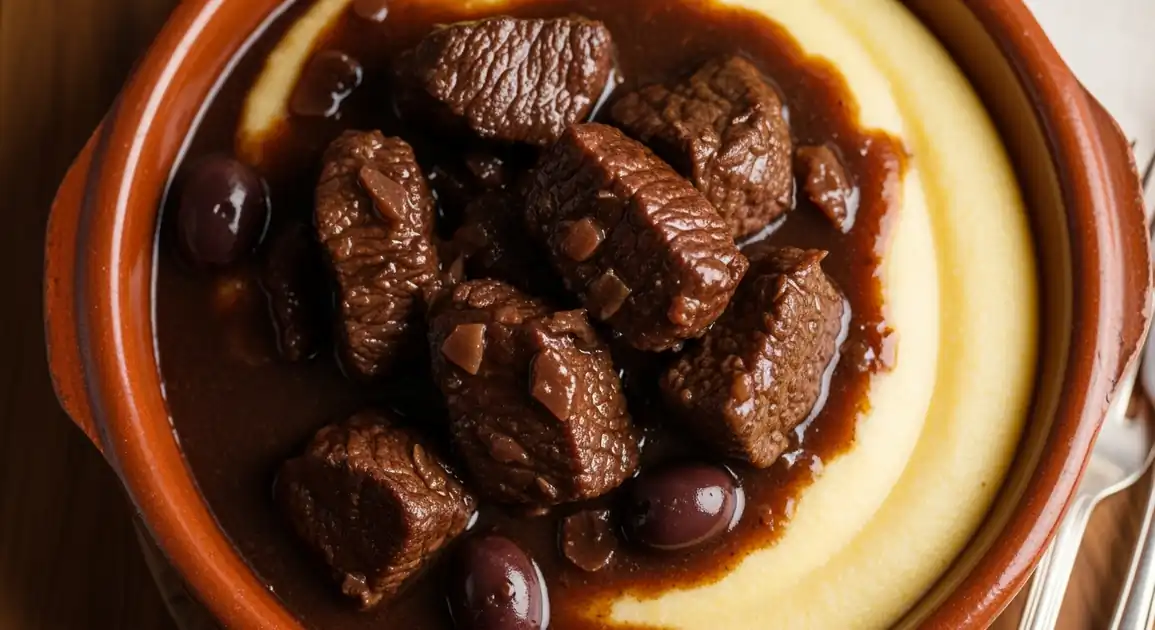Daube Niçoise
Daube Niçoise

Description
In Nice, Daube Niçoise isn't just a dish; it's a culinary emblem. Found widely in restaurants throughout the city, especially in the Old Town (Vieux Nice), it's prepared with local pride, often featuring cèpes, Niçoise olives, and served with gnocchi or polenta. Look for restaurants certified with the 'Cuisine Nissarde' label for guaranteed authenticity.
Dietary Information
Serving information
Serving style
Served hot as a main course in a bowl or deep plate, almost always offered with a choice of local accompaniments: gnocchi, polenta, or sometimes fresh pasta (tagliatelle).
Quick facts
Lunch: 12 PM - 2 PM/2:30 PM. Dinner: 7 PM / 7:30 PM - 10 PM / 10:30 PM.
Safety Tips
What to Look For
-
Served piping hot
Ensures the dish is freshly heated to safe temperatures, crucial for slow-cooked meat dishes.
-
Reputable restaurant with clean premises
Choose restaurants known for good hygiene and quality food, especially those specializing in local cuisine.
-
Meat is extremely tender
Authentic daube requires long cooking, which ensures tenderness. Tough meat might suggest rushed or improper preparation.
-
Rich, savory aroma
The dish should smell deeply savory and appealing. Any off or sour smells are a red flag.
What to avoid
-
Lukewarm or cool stew
Indicates improper holding or reheating, a significant food safety risk.
-
Restaurants with poor hygiene ratings or visibly dirty conditions
Increases the risk of contamination.
-
Tough or chewy beef
Suggests undercooking or poor quality meat, potentially affecting both taste and safety if not cooked long enough.
-
Watery or thin sauce
While not primarily a safety issue, it indicates poor quality and lack of slow cooking.
Price information
Price range
Budget tips
- Check menus in the less-crowded streets of Vieux Nice or slightly outside the main tourist zones.
- Consider having it as part of a fixed-price lunch menu ('formule midi').
- Street food options won't typically include Daube Niçoise; it's a restaurant dish.
Value indicators
- Restaurant holds the 'Cuisine Nissarde' authenticity label.
- Menu explicitly mentions cèpes or Niçoise olives.
- Beef is exceptionally tender, sauce is rich and not watery.
- Served with freshly made gnocchi or proper polenta.
Where to Find This Dish
Vieux Nice (Old Town)
The heart of traditional Niçoise cuisine, packed with restaurants offering Daube Niçoise. Check reviews diligently.
Cours Saleya, Place Rossetti, Cathedrale Sainte-Reparate
Lunch, Dinner
Port Lympia Area
Several good restaurants around the port area also specialize in local dishes.
Nice Port, Place Garibaldi (nearby)
Lunch, Dinner
Restaurants with 'Cuisine Nissarde' Label
Look for the official city label certifying authentic Niçoise recipes anywhere in Nice.
Various locations
Lunch, Dinner
Vendor Tips
- Prioritize restaurants with the 'Cuisine Nissarde' label for authenticity.
- Ask what the daube is served with ('Servi avec quoi?'); gnocchi and polenta are most traditional.
- Reservations are often recommended, especially for dinner at popular spots in Vieux Nice.
- Confirm if 'fait maison' (homemade).
How to Order
Regional Variations
-
Gnocchi vs Polenta
(Gnocchis ou Polenta)
The choice of accompaniment is key in Nice. Both creamy polenta and potato gnocchi (often 'à la niçoise' style, meaning simple) are traditional and widely offered.
-
Use of Cèpes vs Other Mushrooms
(Cèpes ou Autres Champignons)
While cèpes are traditional, availability might lead some restaurants to use other flavorful mushrooms like 'pleurotes' (oyster mushrooms).
-
Intensity of Orange Zest
(Intensité du Zeste d'Orange)
The presence and amount of orange zest can vary, subtly changing the aromatic profile.
Cultural context
History
Daube itself is a classic Provençal dish with peasant origins, designed to tenderize tougher cuts of beef through long, slow cooking in a 'daubière' (a specific pot). The 'Niçoise' variation reflects the local terroir of the Nice area, incorporating ingredients readily available like olives and wild mushrooms (cèpes). It became a staple of Niçoise family Sunday lunches and traditional restaurant menus, embodying the region's culinary identity.
Local significance
Daube Niçoise is a source of local pride and a defining dish of Nice's distinct culinary tradition ('Cuisine Nissarde').
Eating customs
- Eaten as a main course, often following local appetizers like Pissaladière or Salade Niçoise.
- Using bread or the side dish to soak up every bit of the flavorful sauce is encouraged.